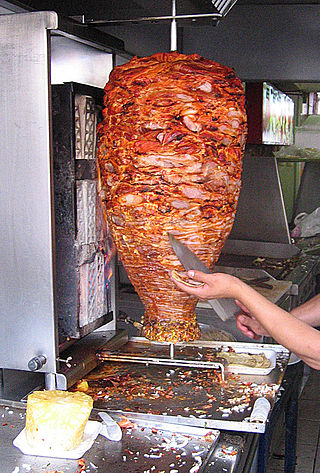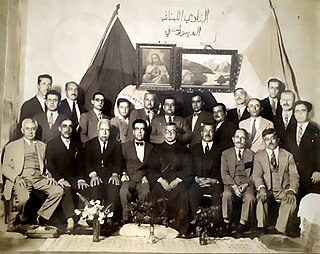Related Research Articles

Arab diaspora is a term that refers to descendants of the Arab emigrants who, voluntarily or as forcibly, migrated from their native lands to non-Arab countries, primarily in the Americas, Europe, Southeast Asia, and West Africa.
Arab Canadians come from all of the countries of the Arab world. According to the 2021 Census, there were 690,000 Canadians, or 1.9%, who claimed Arab ancestry. According to the 2011 census there were 380,620 Canadians who claimed full or partial ancestry from an Arabic-speaking country. The large majority of the Canadians of Arab origin population live in either Ontario or Quebec.

Al pastor, tacos al pastor, or tacos de trompo is a preparation of spit-grilled slices of pork originating in the Central Mexican region of Puebla and Mexico City, although today it is a common menu item found in taquerías throughout Mexico. The method of preparing and cooking al pastor is based on the lamb doner brought by Lebanese immigrants to the region. Al pastor features a flavor palate that uses traditional Mexican adobada (marinade). It is a popular street food that has spread to the United States. In some places of northern Mexico and coastal Mexico, such as in Baja California, taco al pastor is known as taco de trompo or taco de adobada.

Arab Brazilians are Brazilian citizens of Arab ethnic, cultural, linguistic heritage and identity. The majority of Arab Brazilians trace their origin to the Levantine region of the Arab World, known in Arabic as Bilad al-Sham, primarily from Lebanon and Syria, as well as Palestine. Arab Brazilians are Christians in the great majority. The first Syrians and Lebanese arrived in São Paulo around 1880. It is not known exactly when, although the Syrians and Lebanese say that in 1885 there was a small core of peddlers working in the market square. By 1920, the census listed 50,246 Syrians and Lebanese in Brazil, 38.4% (2/5) of these in the state of São Paulo. The 1940 census enumerated 48,614 Syrians, Lebanese and other related groups with a decrease of approximately 1647 people. As immigration almost ceased after 1929 and the colony aged, it is surprising that the decline was not even greater. The trend of the period between 1920 and 1940 was the continuous concentration of Syrians and Lebanese in São Paulo. Almost half (49.3%) of Syrians and Lebanese residents in Brazil lived in São Paulo.

The Lebanese people are the people inhabiting or originating from Lebanon. The term may also include those who had inhabited Mount Lebanon and the Anti-Lebanon Mountains prior to the creation of the modern Lebanese state. The major religious groups among the Lebanese people within Lebanon are Shia Muslims (27%), Sunni Muslims (27%), Maronite Christians (21%), Greek Orthodox Christians (8%), Melkite Christians (5%), Druze (5%), Protestant Christians (1%). The largest contingent of Lebanese, however, comprise a diaspora in North America, South America, Europe, Australia and Africa, which is predominantly Maronite Christian.
Palestinians in Chile are believed to be the largest Palestinian community outside of the Arab world. There are around 6 million Palestinians living in diaspora, mainly in the Middle East. Estimates of the number of Palestinian descendants in Chile range from 450,000 to 500,000.
Hispanic and Latin American Australians refers to Australians who are of Hispanic, and/or Latin American origin irrespective of their ancestral backgrounds, and their descendants. Brazilian Australians make up the largest proportion of Hispanic and/or Latin American Australians, followed by Chilean Australians and Salvadoran Australians. Most Hispanic and Latin American Australians speak English but many continue to use Spanish or Portuguese as well.
Arab Chileans are Chileans from predominantly Arab ancestry. People from the Arab world arrived in Chile as early as the mid-19th century. Historically, the Arabs of Chile were called Turks, Moors, Syrians, Lebanese, or Palestinians.

Maronites are a Syriac Christian ethnoreligious group native to the Eastern Mediterranean and Levant region of West Asia, whose members traditionally belong to the Maronite Church, with the largest concentration long residing near Mount Lebanon in modern Lebanon. The Maronite Church is an Eastern Catholic sui iuris particular church in full communion with the pope and the rest of the Catholic Church.
This is a list of notable Lebanese individuals born in the Lebanese diaspora of Lebanese ancestry or people of dual Lebanese and foreign nationality who live in the diaspora.
Lebanese Chileans, are immigrants to Chile from Lebanon. Most are Christian and they arrived in Chile in the mid-19th to early-20th centuries to escape from poverty. Ethnically Lebanese Chileans are often called "Turks", a term believed to derive from the fact that they arrived from present day Lebanon, which at that time was occupied by the Ottoman Turkish Empire. Most arrived as members of the Eastern Orthodox church and the Maronite church, but became Roman Catholic. A minority are Muslim.
Arabs in Romania are people from Arab countries who live in Romania. The first Fellah settlers came in 1831 - 1833 from Ottoman Syria to Dobruja. They assimilated in the Turkish-Tatarian Population. Some of them came to Romania during the Ceaușescu era, when many Arab students were granted scholarships to study in Romanian universities. Most of them were Lebanese, Syrians, Palestinians, Iraqis, Libyans, Egyptians, and Jordanians. Most of these students returned to their countries of origin, but some remained in Romania starting families here. It is estimated that almost half a million Middle Eastern Arabs studied in Romania during the 1980s. A new wave of Arab immigration started after the Romanian Revolution. Many of the newly arrived Arabs came to Romania in the 1990s in order to develop businesses. In addition, Romania has people from Arab countries who have the status of refugees or illegal immigrants, primarily from North Africa, trying to immigrate to Western Europe. In particular, the European migrant crisis lead to Syrian people coming to Romania, although many Syrians were already living in Romania at the time of the crisis.

In the narrow sense, Lebanese people in Germany include migrants from Lebanon living in Germany and their descendants, excluding Palestinians.

The Palestinian diaspora, part of the wider Arab diaspora, are Palestinian people living outside the region of Palestine.
Lebanese people in Spain are people from Lebanon or those of Lebanese descent, who live in the country of Spain. Most of the Lebanese people in Spain are expatriates from Lebanon but also there is a sizable group of people with Lebanese descent from Latin American countries with sizable Lebanese diasporas like Argentina, Colombia, Ecuador, Venezuela, Mexico, Uruguay, Chile, Paraguay and Brazil.